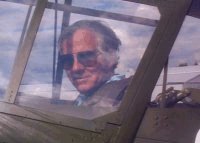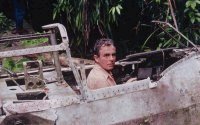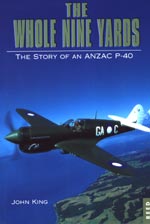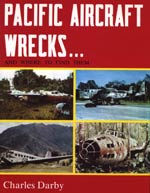Charles Darby
Author, Wrecks and Aircraft Restorer
|
Tell a little about yourself, and your background
Born in England in 1942, first clear aircraft memories
are of a row of Stirlings stored in a field, and of climbing into an
Oxford at an active base in southern England. Interested in aircraft
as long as I can recall, but first flight was not until 1954 in BEA's
Dakota G-AGJW, followed by flights in PanAm DC4s, CPA DC6s, Qantas
Super Connies etc . Came to New Zealand in 1955, and lived in a house
under the Whenuapai Air Base circuit, so was able to watch the Harvards,
Hastings, Freighters, & Avenger target tugs, and visiting Lincolns,
Lancasters, Stratocruisers, Connies etc. The mighty Sunderlands from
5 Squadron and the Maritime Conversion Unit operated from the water
at the end of our street, where many a school day was spent watching
them doing conversion training.
|

Charles Darby in the
cockpit of
P-40N A29-448

Darby in cockpit

The Whole Nine Yards |
What got you interested in WWII aircraft?
I learned about the dump areas near Rukuhia Airfield (Hamilton Airport) in New Zealand, and spent many days investigating the 102 P-40 hulks
(plus three Corsairs and two Hudson fuselages) that were all that was
left of the hundreds of RNZAF wartime aircraft scrapped there. By the
early 1960s those visits had led to a decision to acquire a P-40 "for
restoration", a story told in greater detail in a new book The
Whole Nine Yards - Story of an Anzac P-40 by well-known New Zealand author John King.
The Papua New Guinea (PNG) connection started with my father, who managed
coconut plantations in the Ninigo Islands off the north coast of New
Guinea in the 1930s (in addition to doing many other interesting jobs
in his life). His stories of New Guinea and collection of the bird of
paradise stamps from that time ensured that I wanted to see the place
for myself, which I did for the first time in 1963–1964.
When did you begin
visiting wrecks and photographing them?
In the early 1960s, visiting dumps and wreck sites
was the only way to see wartime aircraft or parts thereof - there was
no warbirds movement then, no "gate-guards", no air force
museums, even the War Memorial Museum in Auckland didn't have any aircraft
on display. And the idea of private owners flying Catalinas, Kittyhawks,
Meteors, Vampires, B-17s, B-25s etc was so far-fetched that it never
even occurred to most people interested in aircraft. And there were
no serious "warbird" reference books either. Not one. Not
until 1964, when Harleyford published their "Aircraft Camouflage
and Markings". That was like publication of the Bible!! Young
men such as Don Subritsky, John Smith and myself who haunted dumps
and wreck sites and collected derelict hulks of P-40s or whatever were
regarded as more than a little strange - feelings which commonly turned
to serious green-eyed jealousy and vindictiveness on the part of their
one-time detractors a quarter of a century later.
Speak about the book Pacific Aircraft Wrecks
The book was prepared at the suggestion of Geoff Pentland
who, even back in the mid-1970s, felt that the subject and the title
he conceived for the book would be a winner. Geoff was founder and
Governing Director of the greatly-respected Kookaburra Technical Publications,
a publishing house that focused on top-quality material and top-quality
printing standards.
 Most of the photos were taken in the course of locating,
identifying, and working on the recovery of derelict warbirds in PNG
and the Solomons for David Tallichet's Yesterday's Air Force [Today,
known as MARC Military Aircraft Restoration
Company (MARC)]. The operations were planned as a consequence of a surprise
phone call to me in New Zealand from David Tallichet in the USA. I set
up an exploration trip, identified the aircraft locations, and organized
the subsequent main recovery operation, and David assigned one of his
workers, Monty Armstrong, to head up the on-site dismantling and recovery
work with my assistance. Most of the photos were taken in the course of locating,
identifying, and working on the recovery of derelict warbirds in PNG
and the Solomons for David Tallichet's Yesterday's Air Force [Today,
known as MARC Military Aircraft Restoration
Company (MARC)]. The operations were planned as a consequence of a surprise
phone call to me in New Zealand from David Tallichet in the USA. I set
up an exploration trip, identified the aircraft locations, and organized
the subsequent main recovery operation, and David assigned one of his
workers, Monty Armstrong, to head up the on-site dismantling and recovery
work with my assistance.
In the course of these operations about 30
aircraft were recovered including P-40s, P-39s, an A-20, Boomerangs,
and Spitfires We had a most interesting and challenging year of work
that resulted in the recovery of P-40s that are now flying in New Zealand
and Australia, and in a couple of years perhaps also in the USA a Beaufort
on display at the RAF Museum in London, and of course other aircraft
that are on display or under restoration at locations throughout Australia
and the USA.
Explain the research behind it
Aircraft identification was based on my own records
and research, most of which was obviously - derived from the evidence
remaining on, in, and around the aircraft themselves. Bruce Hoy had
not appeared in PNG at that time, hence was not a factor. Bill Chapman,
who started the Air Museum of PNG, was a great character to talk with,
as was his wife Arna whose family had a long-term connection with PNG
aviation through Papuan Airlines. They were also, of course, the predominant
facilitators in making it possible at government level to salvage the
aircraft that we did. However, they had virtually no input into investigating
the history of individual aircraft.
Any interesting anecdotes
about making the book?
An early lesson was to take all possible steps to understand
what I was dealing with. As an example, walking up to the sad remains
of yet another crashed "Betty", noticing some unusual early-war
camouflage colours on fabric fragments and becoming aware of other
non-standard features without really registering what they actually
were, then finally realizing that I was looking at one of the exceedingly
rare Mitsubishi G6M1s.
Another lesson was not to
rely on other people's aircraft identification skills. During many
visits to a certain area over 20 years, I didn't bother to walk
out to the well-known shattered remains of a "B-24" that was said to have disintegrated in the air
and crashed "behind the hill". One afternoon, with nothing
else to do, I decided to go take a look at the bits of scrap metal that
were supposed to be lying in the forest. And found that it was actually
a US Navy TDR-1, the Allies' first purpose-built unmanned bomber or "guided
missile", that had been shot down on an operational mission against
a Japanese radar station.
Another lesson was never to
believe that "there
is nothing left there". After weeks of work involving dozens of
people at the American end of one of the Tadji strips, with all the
aircraft we wanted already recovered, all our equipment removed, and
all personnel gone, I stayed behind to do one last scour of the area
for dropped tools etc. And found a large dump of corroding antipersonnel
bombs stretching for several yards (OK, metres) within inches (cm, if
you insist) of our main vehicle access track into the area. Then it
started to rain, and since there were no more aircraft to use as shelter
I moved into the regrowth scrub beside where the now-recovered aircraft
had been. And there was a complete P-39N named "Small Fry".
Same thing happened at Nadzab: "experts" told us there was
nothing left, but we found the remains of 22 aircraft in one single
afternoon, several of which were salvaged.
Pacific
Aircraft Wrecks alludes to a second book
The allusion to a second book was one of Geoff's
promotional ideas, but the reality is more elusive! The book has
not been written, but the idea has not entirely been abandoned. Would
it be worth it? Would many people like to see previously-unpublished
detail photos of the aircraft remains, triple-A batteries, Japanese
radar stations, coast defence guns and so on? There's no more "complete" aircraft
to reveal, unfortunately. Perhaps a start on follow-up books is about
to be made with John King's "The
Whole Nine Yards", mentioned above, which details the total
restoration to airworthy of one of the P-40Ns recovered from PNG during
the YAF expeditions. Indeed it is the first of those recovered wrecks
to be rebuilt and take to the air again.
How do you feel about the book today?
I am surprised, gratified, and more than a little humble
to reflect on the chances and circumstances that came together in such
a manner that I was able to do the work that led to the book. That
the book is still regarded as definitive after nearly thirty years
is both astonishing and sad. Astonishing that no-one has out-performed
the results of an operation that, in essence, was planned and carried
out by a couple of youngsters barely out of their teens, and sad that
the opportunity for others to do so apparently no longer exists. I
also reflect, as in so many other fields, on the crass, self-serving
stupidity of politicians who forbid the export of war relics in the
form of aircraft wrecks, even where such export could result in major
gains of war relics restored for national and local collections as
well as for the exporters themselves.
What is your opinion
about recovery versus leaving wrecks?
If aircraft relics are recovered they have
a chance of survival. The exception is relics in the sea. I am not aware
of any process that is within the bounds of economic reason whereby
an aircraft can be recovered from the sea and preserved indefinitely,
let alone restored to airworthy condition. In that situation I believe
it is usually best to leave them in the sea, where they are more likely
to survive than if they are dragged ashore.
Again there's an exception relics from the sea may provide parts
for use as patterns that cannot be found elsewhere, or small parts
such as stainless steel items that are still recoverable. Another exception
may be where there is literally unlimited long-term funding to decontaminate
and preserve an aircraft recovered from the sea.
How do you feel about aircraft recovery?
Very simple. If aircraft relics are recovered they have a chance of survival. If they are left in situ they will, with no shadow of doubt, corrode into the ground if they are not scrapped, bulldozed, or burnt first. The exception is relics in the sea. I am not aware of any process that is within the bounds of economic reason whereby an aircraft can be recovered from the sea and preserved indefinitely, let alone restored to airworthy condition. In that situation I believe it is usually best to leave them in the sea, where they are more likely to survive for a few more decades than if they are dragged ashore. Again there's an exception --- relics from the sea may provide parts for use as patterns that cannot be found elsewhere, or small parts such as stainless steel items that are still recoverable. Another exception may be where there is literally unlimited long-term funding to decontaminate and preserve an aircraft recovered from the sea.
Public collections, on the
other hand, have an odious record. This includes government and
air force collections and the majority of "committee-run" museums, where the integrity of an asset
in terms of its original paint and systems fit and even its existence,
depends on the politicians or board members in charge at the time. The
American, Australian, Belgian, British, and New Zealand national and/or
air force aviation collections all have disgraceful histories of asset
destruction and degradation of historical material. And I am talking
about the 1980s and 1990s, not "ancient history". Sure, the
national collections of those nations have improved their acts in recent
years, but suspicion remains because indefensible crimes of asset destruction
and "rewritten history" still come to light. Often these events
result from the actions of uninterested "time-servers" in
positions of authority, where a private individual interested in aviation
history would never have acted in such a manner.
Tell about your restoration company Pacific Aircraft Ltd
I founded Pacific Aircraft Ltd with Jim Pavitt
as equal 50% shareholders in the mid-1990s. Warren Denholm was our
General Manager/Chief Engineer until he left to set up his own company
and Robert McNair our Engineering Foreman. Subsequently we sold the
business to Garth Hogan, who re-organised and re-developed it as Pioneer
Aero Restorations Ltd. Pacific consisted essentially of some tooling
and assembly structures with limited hardware value, but with the critical
asset of well-qualified engineering specialists who had become the
world's best P-40 restoration team. Today, Robert is still the engineering
foreman, and other long-term "inmates" from Pacific days
include Callum Smith and Derek Smith (not related) and others who turn
up repeatedly on a part-time or temporary basis. I'm now just an interested
bystander who helps with parts and tech manuals. Pioneer
Aero Restoration is Garth Hogan's company, and restored one of the
P-40's recovered from Tadji.
 Which aircraft
you recovered are airworth? Which aircraft
you recovered are airworth?
P-40N
A29-448 is no longer the only aircraft recovered
in the "Pacific Aircraft Wrecks Mission" that is now flying
- Murray Griffith's P-40N
42-105915 is now elegantly airworthy again. Next to take the
air will probably be John Fallis' P-40N 42-105861 in Lafayette, Louisiana.
Any upcoming projects on the horizon?
I have learned the hard way that it is better to be
reticent about upcoming or future projects until such time as they
are under way. Ongoing projects include building up a library of technical
manuals that can be copied to support restoration projects and ensure
that they can be carried out "in accordance with" relevant
documentation --- an essential requirement in many civil aviation jurisdictions.
Also building up a collection of WW2 airborne radio, radar, elint,
ASV and similar systems.
Thank you Mr. Darby for the interview
Read Review of Pacific
Aircraft Wrecks.. And Where to Find Them | The Whole Nine Yards
|